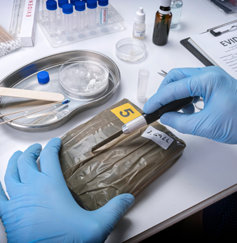CDC Reports U.S. Overdoses Reach New High

The Centers for Disease Control and Prevention (CDC) releases frequent updates as to the rate and number of overdose deaths occurring in the U.S. in any given period. This data provides direct insight into the scope of drug use in America, what types of drugs Americans are using, and which drugs are causing the most deaths. The latest findings suggest the U.S. drug addiction epidemic is continuing to escalate.
CDC Data
On October 1, 2023, the CDC released provisional findings for the total number of drug overdose fatalities that had occurred in the U.S. in the 12 months between April 2022 and May 2023. According to the data, 112,024 people died from drug overdoses in that period, compared to the 110,394 overdose deaths recorded from February 2021 to March 2022 (i.e., the previous year).
These findings came at a time when many health experts were anticipating drug overdose fatalities to decline as the U.S. came out of the COVID-19 pandemic. “I was expecting that overdose deaths would go down after the big jump during the Covid pandemic, as we resume our everyday life,” said Dr. Nora Volkow, director of the National Institute on Drug Abuse at the National Institutes of Health. “So to me, it is very concerning that these numbers remain so elevated.” In all but 19 states, overdoses rose during the examined period.
“I was expecting that overdose deaths would go down after the big jump during the Covid pandemic, as we resume our everyday life.
So to me, it is very concerning that these numbers remain so elevated.”
While the pace of the increase in deaths has slowed, the trend is still moving upward. According to the CDC, overdoses spiked 30% in 2020 and 15% in 2021. The newest data suggests they increased by 4% in 2022. While the rate of the increase is slowing, a mind-boggling number of people are still losing their lives every year to drugs, with drug overdoses now one of the leading causes of preventable death in America.
One Type of Drug Claims the Vast Majority of Lives
While many different types of drugs are in use in the U.S., it’s primarily just a handful of drugs that are causing the overwhelming majority of fatal overdoses. The CDC reports that fentanyl and other extremely potent synthetic opioids are present in nearly 70% of all overdose deaths, meaning two out of every three overdose fatalities in the U.S. are connected to one type of drug, i.e., opioids.

Further, even when people with an addiction intentionally attempt to avoid fentanyl and other opioids, they often cannot. Fentanyl has been mixed into drug supplies across the country without users knowing, meaning no type of drug is “safe,” even when users are trying to be mindful of what they’re using. “Fentanyl is everywhere,” Volkow said. “It’s not just disguised as heroin, but it’s also actually present in cocaine and methamphetamine.” The fact that fentanyl has been added to other drugs makes all forms of drug use extremely dangerous and life-threatening.
A Closer Look at Fentanyl and Synthetic Opioids
Fentanyl is a powerful opioid, similar to heroin and morphine, but about ten times more potent than heroin and 50-100 times more potent than morphine. While fentanyl has medical uses as a high-strength pain reliever for post-surgery pain, end-of-life care, cancer treatment, and some limited chronic pain scenarios, fentanyl is so potent it can easily be fatal when used experimentally. Reports have suggested the drug is so strong one can experience an overdose simply by getting some of the drug on their skin.
Since fentanyl became a sought-after drug among users in the mid-2010s, many clandestine drug labs across the world began producing the drug illegally, sometimes making similar synthetic opioids that included other chemicals and additives. Today, most of the overdoses caused by fentanyl and other synthetic opioids are caused by illicitly-made fentanyl and illicitly-manufactured opioids, not pharmaceutical fentanyl or pharmaceutical opioid painkillers.
People seek fentanyl because the drug can produce a sense of drowsiness and dulled euphoria. But the drug also produces nausea, confusion, constipation, difficulty breathing, sedation, and unconsciousness. As soon as a user stops taking fentanyl, they will likely experience withdrawal symptoms like muscle and bone pain, sleep problems, diarrhea, vomiting, cold flashes with goose bumps, uncontrollable leg movements, and severe cravings. These symptoms can become unbearably painful and distressful.
When people take even a very small amount of fentanyl, they can experience hypoxia, a condition in which their breathing slows so much that insufficient oxygen reaches the brain. This precipitates an overdose and can include unconsciousness, coma, permanent brain damage, and even death.
The Need for Quality Addiction Treatment as Soon as Possible
To counteract the rising death toll, in March 2023, the U.S. Food and Drug Administration approved the over-the-counter provision of naloxone to the public. Naloxone is an emergency overdose medication designed to save the lives of people who are experiencing an opioid overdose. When applied quickly, naloxone can reverse an overdose.

However, even if naloxone helps make a dent in the death toll, it is not a permanent solution. “Naloxone is necessary but completely inadequate,” said Caleb Banta-Green, a research professor at the University of Washington School of Medicine. To Banta-Green’s point, people who are addicted to opioids must receive real and lasting help by means of qualified addiction treatment to address the underlying reasons why they began using drugs. Naloxone may save their life today, but treatment for addiction will save their life tomorrow and in the days, weeks, months, and years to come.
If you know someone who is addicted to drugs, please help them find and enter a residential addiction treatment center as soon as possible. Please do not wait until it is too late. All it takes is one exposure to fentanyl or a similar synthetic opioid to end someone’s life, and addicts today have almost no way of knowing if the drugs they’re using have such substances in them. Help your loved one enter treatment today.
Sources Cited:
- CDC. “Provisional Drug Overdose Death Counts.” Centers for Disease Control and Prevention, 2023. cdc.gov
- CNN. “Overdose deaths continue to rise in the U.S., reaching another record level, provisional data shows.” CNN, 2023. amp.cnn.com
- CDC. “U.S. Overdose Deaths In 2021 Increased Half as Much as in 2020 – But Are Still Up 15%.” Centers for Disease Control and Prevention, 2022. cdc.gov.
- NIDA. “What is Fentanyl?” National Institute on Drug Abuse, 2021. nida.nih.gov


 ®
®